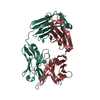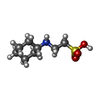+Search query
-Structure paper
| Title | Identification of IOMA-class neutralizing antibodies targeting the CD4-binding site on the HIV-1 envelope glycoprotein. |
|---|---|
| Journal, issue, pages | Nat Commun, Vol. 13, Issue 1, Page 4515, Year 2022 |
| Publish date | Aug 3, 2022 |
 Authors Authors | Jelle van Schooten / Elinaz Farokhi / Anna Schorcht / Tom L G M van den Kerkhof / Hongmei Gao / Patricia van der Woude / Judith A Burger / Tim G Rijkhold Meesters / Tom Bijl / Riham Ghalaiyini / Hannah L Turner / Jessica Dorning / Barbera D C van Schaik / Antoine H C van Kampen / Celia C Labranche / Robyn L Stanfield / Devin Sok / David C Montefiori / Dennis R Burton / Michael S Seaman / Gabriel Ozorowski / Ian A Wilson / Rogier W Sanders / Andrew B Ward / Marit J van Gils /   |
| PubMed Abstract | A major goal of current HIV-1 vaccine design efforts is to induce broadly neutralizing antibodies (bNAbs). The VH1-2-derived bNAb IOMA directed to the CD4-binding site of the HIV-1 envelope ...A major goal of current HIV-1 vaccine design efforts is to induce broadly neutralizing antibodies (bNAbs). The VH1-2-derived bNAb IOMA directed to the CD4-binding site of the HIV-1 envelope glycoprotein is of interest because, unlike the better-known VH1-2-derived VRC01-class bNAbs, it does not require a rare short light chain complementarity-determining region 3 (CDRL3). Here, we describe three IOMA-class NAbs, ACS101-103, with up to 37% breadth, that share many characteristics with IOMA, including an average-length CDRL3. Cryo-electron microscopy revealed that ACS101 shares interactions with those observed with other VH1-2 and VH1-46-class bNAbs, but exhibits a unique binding mode to residues in loop D. Analysis of longitudinal sequences from the patient suggests that a transmitter/founder-virus lacking the N276 glycan might have initiated the development of these NAbs. Together these data strengthen the rationale for germline-targeting vaccination strategies to induce IOMA-class bNAbs and provide a wealth of sequence and structural information to support such strategies. |
 External links External links |  Nat Commun / Nat Commun /  PubMed:35922441 / PubMed:35922441 /  PubMed Central PubMed Central |
| Methods | EM (single particle) / X-ray diffraction |
| Resolution | 1.73 - 25.0 Å |
| Structure data | EMDB-14474, PDB-7z3a:  EMDB-14475: AMC009 SOSIPv5.2 + ACS101 Fab  EMDB-14476: AMC009 SOSIPv5.2 in complex with ACS102 Fab  EMDB-14477: AMC009 SOSIPv5.2 in complex with ACS103 Fab  EMDB-14478: AMC009 SOSIPv5.2 in complex with ACS124 Fab  PDB-7u04:  PDB-7u0k: |
| Chemicals |  ChemComp-GOL:  ChemComp-HOH:  ChemComp-NHE:  ChemComp-NAG: |
| Source |
|
 Keywords Keywords |  IMMUNE SYSTEM / IMMUNE SYSTEM /  Antibody / Antibody /  IOMA / IOMA /  HIV / HIV /  STRUCTURAL PROTEIN / STRUCTURAL PROTEIN /  VIRAL PROTEIN / VIRAL PROTEIN /  HIV-1 / HIV-1 /  antibodies / CD4-binding site / gp41-gp120 interface antibodies / CD4-binding site / gp41-gp120 interface |
 Movie
Movie Controller
Controller Structure viewers
Structure viewers About Yorodumi Papers
About Yorodumi Papers








